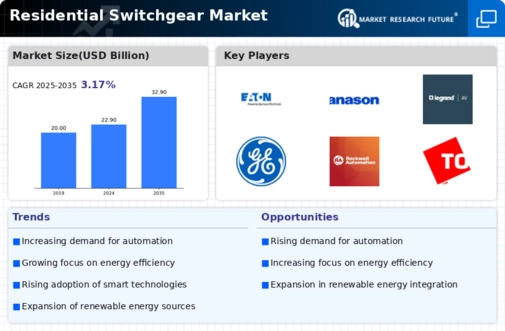Focus on Sustainable Energy Solutions
The growing focus on sustainable energy solutions is significantly influencing the Residential Switchgear Market. As more homeowners seek to incorporate renewable energy sources, such as solar panels, into their residences, the demand for switchgear that can effectively manage these systems is increasing. This shift towards sustainability is supported by various government incentives aimed at promoting renewable energy adoption. Market analysis indicates that the renewable energy sector is poised for growth, which will likely drive the need for compatible switchgear solutions. Manufacturers are thus innovating to create products that facilitate the integration of renewable energy technologies into residential electrical systems.
Growth of Smart Homes and IoT Integration
The proliferation of smart home technologies and the Internet of Things (IoT) is a significant driver for the Residential Switchgear Market. As consumers increasingly adopt smart devices, the need for switchgear that can integrate with these technologies becomes paramount. This integration allows for enhanced control and automation of residential electrical systems, leading to improved energy efficiency and user convenience. Market data suggests that the smart home market is expected to witness substantial growth, which in turn is likely to boost the demand for compatible switchgear solutions. Manufacturers are responding by developing innovative products that cater to the needs of tech-savvy homeowners.
Regulatory Compliance and Safety Standards
Regulatory compliance and safety standards are increasingly shaping the Residential Switchgear Market. Governments and regulatory bodies are implementing stringent safety regulations to ensure the protection of residential properties and their occupants. This has led to a heightened demand for switchgear that meets these evolving standards. For instance, the International Electrotechnical Commission (IEC) has established guidelines that manufacturers must adhere to, thereby driving innovation in switchgear design and functionality. As a result, companies are investing in research and development to produce compliant products that not only enhance safety but also improve reliability and performance in residential applications.
Rising Demand for Energy Management Solutions
The increasing emphasis on energy management solutions is a pivotal driver for the Residential Switchgear Market. As households seek to optimize energy consumption, the demand for advanced switchgear that facilitates energy monitoring and control is surging. According to recent data, the energy management systems market is projected to grow significantly, indicating a parallel rise in the need for efficient switchgear. This trend is further fueled by the growing awareness of energy conservation and the potential for cost savings. Consequently, manufacturers are innovating to provide switchgear that integrates seamlessly with energy management systems, thereby enhancing the overall functionality and appeal of residential electrical installations.
Increased Investment in Residential Infrastructure
The ongoing investment in residential infrastructure is a crucial driver for the Residential Switchgear Market. As urbanization continues to rise, there is a corresponding need for modern electrical systems in new residential developments. This trend is particularly evident in emerging markets, where infrastructure development is accelerating. Data indicates that the construction sector is experiencing robust growth, which is likely to translate into increased demand for switchgear solutions that can support new electrical installations. Consequently, manufacturers are focusing on providing versatile and reliable switchgear that meets the requirements of contemporary residential projects.


















Leave a Comment